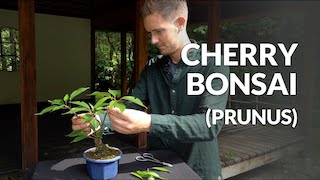Cherry or Prunus Bonsai Care guidelines
The cherry needs a sunny place which is protected from strong winds. During the hottest summer time it can be wise to provide some partial shade. A cool winter dormancy period of at least three months is required. Cherries are frost-hardy, but should be protected from extremely low temperatures, especially when they are planted in small bonsai pots.
Cherry trees need a lot of water during the growing season and the rootball must not dry out, especially while flowers and fruit develop. On the other hand waterlogged rootballs will rot, so always ensure proper drainage. Use rainwater if possible, as cherries don't like very calcareous water. Continue reading about watering Bonsai trees.
Watering
Free lecture from the Beginners CourseDuring the growth period, use a solid organic fertilizer once a month or a liquid fertilizer every week. Use a balanced product and avoid high nitrogen fertilizers for mature trees you want to flower.
The cherry bonsai is not easy to keep in shape. After flowering the older branches can be selected and shortened, if necessary, but take care to leave leaf buds on branches you want to keep. Let the new shoots grow freely for some time. If they are trimmed too early, they often die back. The flower buds for the next season develop in late summer. In autumn the long shoots can be shortened leaving two to five nodes. In winter or early spring, before the new growth appears, you can prune larger branches and, if necessary, wire the tree. Branches which are cut too short might die back after flowering if they don't have leaf buds left. Prunus incisa however buds more reliably than other cherry species.
Wiring can be done best when there are no leaves on the tree. Old branches are quite stiff and brittle but they can be shaped with guy wires in many cases. Younger twigs are flexible and can be shaped easily with wire. You can also wire the new shoots during the growing season. Continue reading about pruning Bonsai trees.
Repot the Bonsai cherry every two or three years, older trees less often, in early spring before the flowers open. The roots of young specimen can be pruned considerably, but those of mature bonsai must be treated more gently and pruned only moderately. Cutting off thick woody roots can be dangerous for old cherry trees. Use a well-draining soil mix with a pH value of 5,5 to 6,5. Continue reading about repotting Bonsai trees.
The cherry can be propagated from seed, cuttings, by air-layering and grafting. Seedlings do not inherit the mother plant's characteristics in most cases. Hardwood cuttings can be taken in spring before the buds open, semi-hardwood cuttings in summer. Most cultivars that are offered in garden centers are grafted and often the rootstock grows faster than the scion which results in a ugly swelling.
Unfortunately cherry trees can be attacked by a lot of different pests and diseases. Aphids, scale, caterpillars, mealy bugs, gall mites and spider mites can affect the cherry as well as fungal diseases like powdery mildew, leaf spot, rust, crown and root rot and verticillium wilt, or bacterial diseases like canker and black knot. Cherry rasp leaf is caused by a virus. In those cases use a specific pesticide or in difficult cases ask a professional gardener for help. Frequent watering with calcareous water can cause chlorosis. For more detailed information on these techniques, check out our Bonsai tree care section.
When does the cherry Bonsai bloom? Depending on your geographical location the cherry trees bloom around March or April.
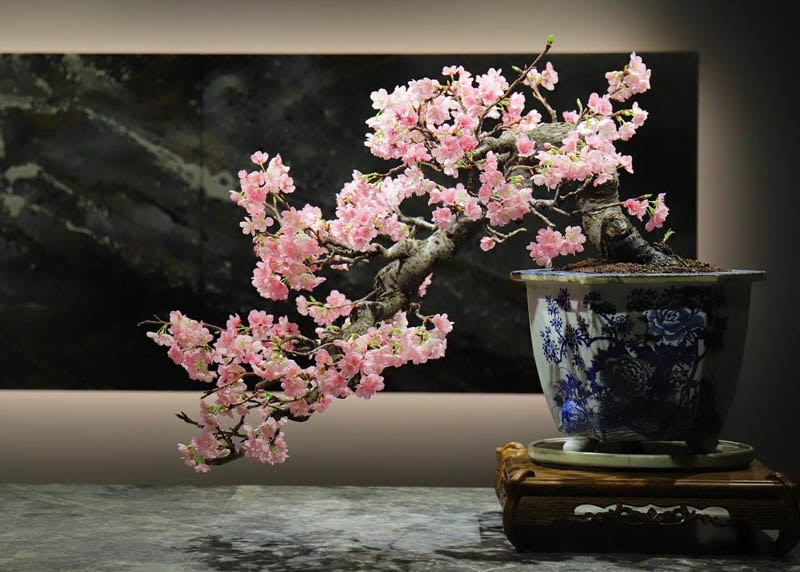
Cherry bonsai tree
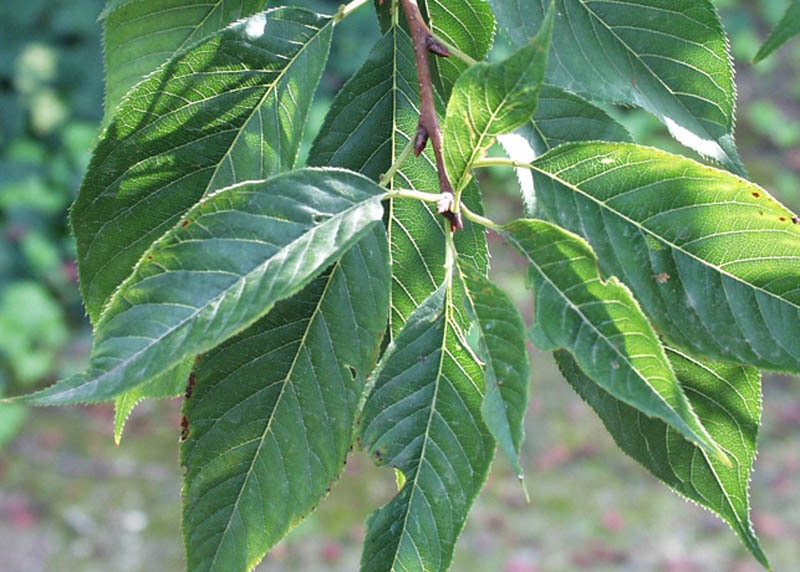
Leaves of the Cherry
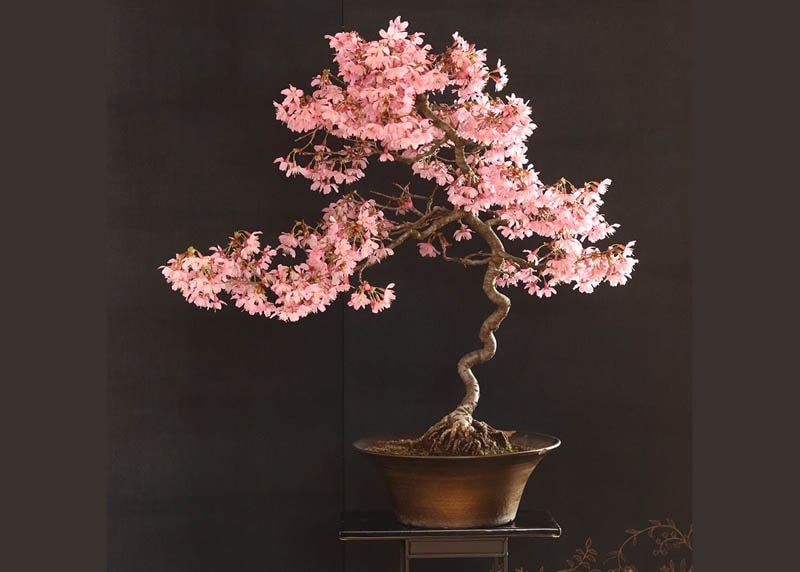
Japanese prunus (Sakura bonsai)
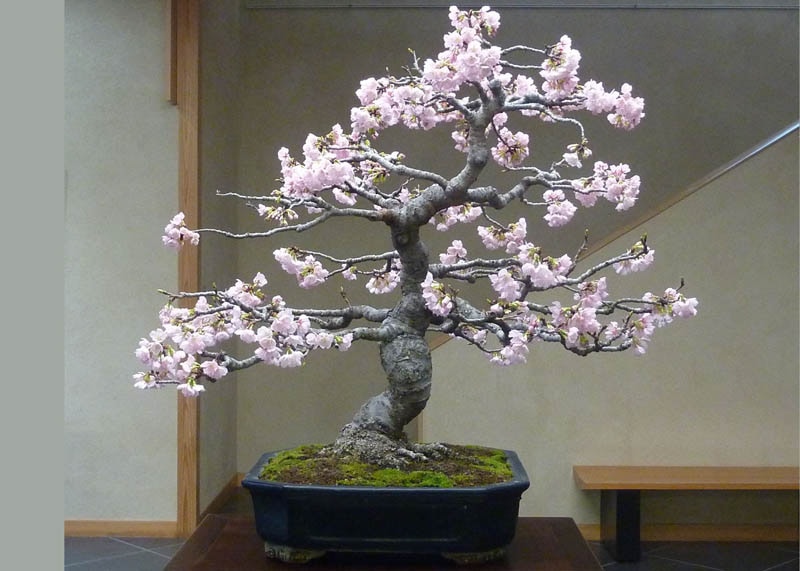
Prunus bonsai in Japan
General information about the Cherry Bonsai tree
In Japan's Nara period (710–794) a tradition began of watching and appreciating the cherry blossom, called Sakura. The short period in which the cherries bloom has become a national obsession and is a period of great importance to the Japanese. Needless to say, many cherry blossom Bonsai trees are kept in Japan. The cherry blossom is a flower of several types cherry trees which are species within the genus Prunus. The most well-known species is the Japanese cherry, Prunus serrulata, which is referred to when we speak of the cherry blossoms.
In most cases Cherries are rather small trees up to 4,5m, but some species can grow up to 30m tall. The trunk becomes dark and gnarly with age. For bonsai the decorative Japanese flowering species are used most often, like cultivars of Prunus serrulata, Prunus incisa, Prunus kurilensis or Prunus subhirtella. The normal fruit species however, like Prunus avium or Prunus cerasus, can also be used. If you need help identifying your tree, take a look at our Bonsai tree identification guide.

